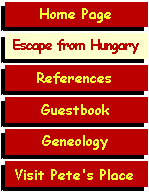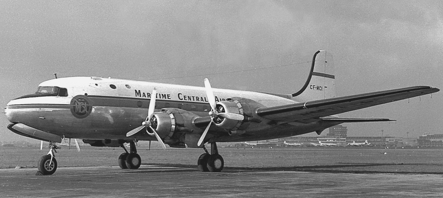![]()

 V.
Canada
V.
Canada
Wednesday, July 3, 1957
 Late
Afternoon: "Our bags are packed, we're ready to
go, . . . " as the song goes. Only we are not leaving on a
jet plane, just a prop; still, it beats traveling by ship.
Each passenger is processed at the airport in the order we
appear on the list. We are first (since we were on the
waiting list for the previous flight a few days earlier); as
is customary, my mother is late and seventy odd people are
nervously awaiting our appearance.
Late
Afternoon: "Our bags are packed, we're ready to
go, . . . " as the song goes. Only we are not leaving on a
jet plane, just a prop; still, it beats traveling by ship.
Each passenger is processed at the airport in the order we
appear on the list. We are first (since we were on the
waiting list for the previous flight a few days earlier); as
is customary, my mother is late and seventy odd people are
nervously awaiting our appearance.
I am first. I have to stand with my bag on a weigh scale with a large dial and a man in a pilot's uniform notes the weight on his clipboard. The others follow suit. As it is later explained, the long overwater flight requires careful management of fuel and consequently the aircrew requires the exact weight of the aircraft.
We finally complete formalities and board the waiting aircraft. I was naturally nervous, this being my first ever trip on an airplane. My mother was showing off her superior, but limited knowledge of English; she is the only one in our group who could communicate with the Canadian cabin crew and thus becomes the official interpreter for the crossing.
According to my research on the "Air Bridge to Canada" (ABC) flights that were implemented to transport Hungarians from Vienna to Canada, and my fairly extensive knowledge of commercial and military aircraft, my best guess is that we flew on a Douglas C-54 (DC-4) aircraft chartered by the Canadian government from Maritime Central Airways, similar to the one pictured here.
7:00 pm We finally take off toward the setting sun, flying low by today's standards. proceeding westward over other brightly lit cities. Unlike today's jets, these venerable old planes flew low and slow, allowing ample time and opportunity to view the countryside in great detail. Our first fuel stop is Glasgow (Prestwick Airport), Scotland, where we arrive about five and a half hours later.
After Midnight We take off once more into the darkness. The cities and highways of the first leg are replaced by nothing but blackness, both above and below us. We press on for several hours until, around sunrise, we make our second fuel stop in Reykjavik (Keflavik Airport), Iceland. We deplane and eat breakfast at the airport.
Thursday, July 4, 1957
Daybreak We are airborne again, this time the black giving way to grey. The sky above us is grey as are the land and sea below us. Shortly after take-off, people sitting over the wing summon my mother to tell the cabin crew that fuel is leaking from a hole on top of the wing. A short-lived panic ensues, until a pilot comes back to look; he smiles, says it's OK, and disappears past his partition.
 As
the morning sun appears through the now broken clouds, the
passage gets rougher. The plane bounces violently,
relentlessly for what seems like hours on end. My breakfast
soon leaves me in a few violent heaves. What was the object
of curiosity and endless jokes the night before is now
my trusted companion. Today it is known as a "comfort bag"
but a barf bag by any other name is still a barf bag! I
swear to all that, if I ever survive this trip, I will never
see Europe again because I will never cross the ocean
again.
As
the morning sun appears through the now broken clouds, the
passage gets rougher. The plane bounces violently,
relentlessly for what seems like hours on end. My breakfast
soon leaves me in a few violent heaves. What was the object
of curiosity and endless jokes the night before is now
my trusted companion. Today it is known as a "comfort bag"
but a barf bag by any other name is still a barf bag! I
swear to all that, if I ever survive this trip, I will never
see Europe again because I will never cross the ocean
again.
As you can guess, we arrive safely in Moncton, New Bruswick sometime in the afternoon, local time, over eleven hours flying from Iceland. The crossing from Vienna took over twenty-four hours, including the stops; par for the course for 1957.
After being processed again, we spend the night at what I believe was then the RCAF base in Moncton, and board a train the next afternoon for Montreal. Checking the 1957 CNR schedule, it is probably Train 59 - The Scotian (Halifax - Montreal). I recall stopping at daybreak at Levis, Quebec, where we get a magnificent view of the Chateau Frontenac across the river. Changing trains in Montreal - Central Station later that morning, I clearly recall the concourse with the stairways leading down to the tracks. It's still like that today. We now board Train 5 or 7, and finally arrive in Toronto sometime during the afternoon of July 6, 1957. The train ride takes longer than the flight, but at least it's all on terra firma.
My mother's friend meets us at Union Station.
1957 to Present
The following years are typical for an immigrant family. My mother marries another Hungarian refugee whom we met in Vienna and we move to Montreal. In 1959, my sister, Shirley, is born. Typically, she learns Hungarian at home and enrols in nursery school at the age of four without speaking a word of English. Within a month, she can converse with her new friends.
My parents struggle at first, weathering layoffs and homesickness. but we soon reach a standard of living that would be unimaginable in communist Hungary, even after a lifetime of labor. I graduate from McGill University in 1971 with a degree in Engineering and move to British Columbia. There, I obtain a master's degree in Engineering from UBC and, in 1979, I move south to the USA. In 1984, I pick up another master's degree, this time in Business Administration, from a small liberal arts college in my new hometown.
Today, I live the life of a typical American: a wife, 2 children and a paid-off mortgage, living in a small southern city, semi-retired, still working part time in the aerospace industry.
|
IV. Láger Life |
Return to Home Page |
VI. Epilogue |